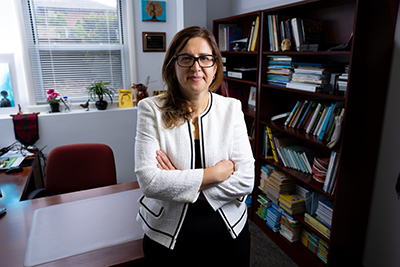
One Adelphi professor's fight to bring change to her field.

Reem Khamis, PhD, professor of communication sciences and disorders
The American Speech-Language-Hearing Association (ASHA) has one core value: Effective communication with others is a human right. To secure that right for all Americans, the organization offers material support to speech-language pathologists, audiologists and the thousands of other professionals who work to diagnose and treat disorders that hinder communication. Yet, according to Reem Khamis, PhD, professor of communication sciences and disorders at Adelphi, ASHA’s ideas about what behaviors count as disordered reflect not a commitment to human rights, but to our country’s history of exclusion.
Prejudiced notions of disorder, Dr. Khamis argues, are leading to the improper care in speech, language and hearing services (SLHS). “As a field, we are over diagnosing and underdiagnosing specific BIPOC groups,” she said, referring to Black, Indigenous and People of Color. “Children who speak African American English are overdiagnosed for language impairment because clinicians have limited knowledge of that linguistic system, and the norms incorporated into our standardized tests are based on the expectations of Standard English, which is really white English. Similarly, there is a tendency to underdiagnose Spanish-speaking children due to the limited knowledge of second-language acquisition.”
To examine the causes and effects of these and other discriminatory practices, Dr. Khamis collaborated with colleagues around the country, forming the Speech, Language and Hearing Scientists Equity Action Collection (EAC), to produce “Making Race Visible in the Speech, Language, and Hearing Sciences: A Critical Discourse Analysis” (American Journal of Speech-Language Pathology, March 2022).1 The paper explores how two key professional standards documents—the Standards for Certification and the Essential Functions rubric—contribute to the discursive construction of the ideal speech-language pathologist and audiologist.
“We believed that critical discourse analysis was the best method of addressing our social justice concerns, “she said. “Through an examination of what is specifically written and what is not written, we can learn about the underlying subtle perspectives, attitudes, values and ideologies related to ethnic and racial inequities in our discipline.”
The team’s conclusions were sobering: “The main finding of the study is that race and racism were excluded from the written document in ways consistent with color-blind racism,” Dr. Khamis said. In other words, by seeking to be race neutral, the SLHS field ultimately perpetuates racist systems. She partially attributes this phenomenon to the racial makeup of the field, as speech pathology and audiology comprise one of America’s 10 whitest professions.
“Not addressing race overtly ultimately limits the access of BIPOC individuals to the discipline and makes it difficult for them to meet academic and clinical standards,” she noted. “We must therefore address race head-on and systematically.”
To help the field better serve marginalized people, Dr. Khamis drew on her experience working with Arab American populations to develop a new pedagogical approach, published as “A Comprehensive Antiracist Framework for SLHS Education: A Sample Curriculum Related to Arab American Populations” (Teaching and Learning in Communication Sciences & Disorders, 2021).2 In this paper, she calls for a collective effort to address racism in higher education by way of intentional, antiracist acts.
“My sample curriculum is unique in that it offers a comprehensive antiracist education that extends beyond the classroom to include learning opportunities in research and community work,” she explained. “Offering authentic community engagement opportunities will help address the isolation of SLHS BIPOC students and connect them with their community to foster a sense of empowerment and belonging.”
Dr. Khamis is mindful that effective collaboration with communities can be difficult to establish, so she offers two pieces of guidance to those seeking to implement a similar curriculum. “One, do not approach community members and organizations from a superior position, “she said. “Two, many communities feel mistrust toward higher education institutions because, historically, these institutions—and researchers in general—have been complicit in the oppression of BIPOC communities.”
Despite the challenges involved, she believes the need could not be more urgent. “Transformation of the SLHS field is not only necessary to address the needs of BIPOC students, but for the survival of the profession,” she said. “The field not only should not be maintained as it is—it cannot be maintained as it is.”
1. Yu, Betty, and RaMonda Horton, Benjamin Munson, Reem Khamis-Dakwar, et al. “Making Race Visible in the Speech, Language, and Hearing Sciences: A Critical Discourse Analysis” (American Journal of Speech-Language Pathology, vol. 31, iss. 2, 10 March 2022, pp. 578-600.
2. Khamis-Dakwar, Reem. “A Comprehensive Antiracist Framework for SLHS Education: A Sample Curriculum Related to Arab American Populations.” Teaching and Learning in Communication Sciences & Disorders, vol. 5, iss. 3, 2021.